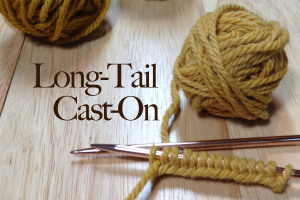When you cast-on with a finger cast-on like the long-tail cast-on, you have to estimate how mu ch yarn to leave in the tail. There is nothing worse than casting-on and getting to the last few stitches and running out of tail yarn!
ch yarn to leave in the tail. There is nothing worse than casting-on and getting to the last few stitches and running out of tail yarn!
Here is a good way to estimate how much allowance to leave for your project:
- Begin by tying a slip knot about 1 to 2 feet away from the end of the yarn
- Cast on 10 stitches
- Pinch the tail of the yarn with your thumb and forefinger where it emerges from the last stitch you cast on
- Slide all 10 stitches off of the needle, leaving your slip knot on the needle
- measure the length of yarn between your fingers and the needle, this will be the amount of tail yarn you need for 10 stitches
- Multiply your measurement by 0ne-tenth of the amount of stitches you need for your cast-on stitches
Here is an example:
- I have a project that requires 60 stitches
- The measurement of my yarn from my fingers to the needle is 5 inches
- 1/10 of 60 (the total number of stitches I want to cast on) is 6
- 5 inches (x) 6 = 30 inches
- My cast-on tail allowance should be 30 inches
I hope this helps when you are casting on for your next project! Please enjoy my Long-Tail Cast-On video:








